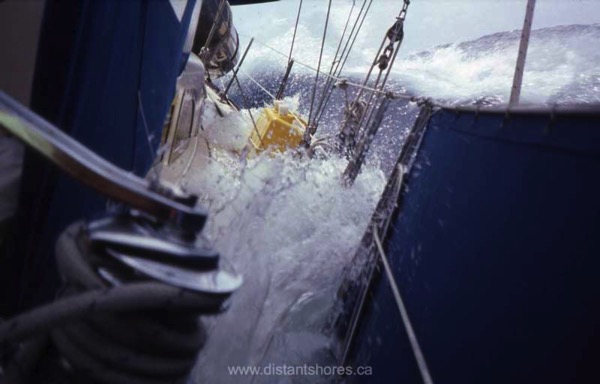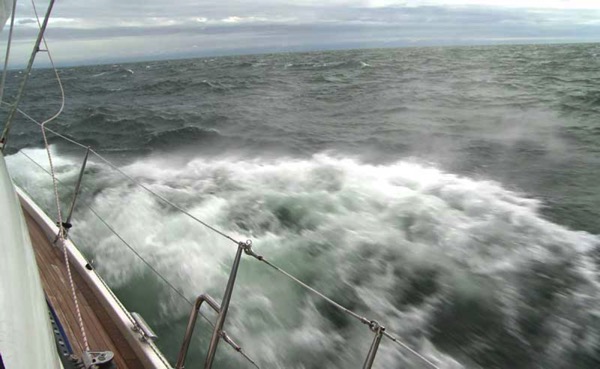When to Abandon Ship?
06/03/15 12:54 Filed in: Offshore sailing
By Paul Shard, Copyright 2015. All rights reserved.

When would you abandon your boat? What set of circumstances would have to occur for you to call for help and be rescued leaving your boat adrift in the ocean?
Recently there have been a few high profile incidents where cruising boats got into trouble, distress calls were broadcast, the crews successfully rescued and the boats were abandoned although they were floating. It got me thinking about that most terrifying of situations, having to abandon the boat.
In the mid-eighties as we were preparing to set sail, we read advice about dealing with storms, keeping the boat afloat, collision systems and heard phrases like “step up into your life-raft” - in other words don’t get up into your life-raft until the boat is sinking beneath your feet.
When we started cruising in 1989 we made easy passages heading south on the coastal route to the Bahamas before tackling an ocean passage to Bermuda the next year. Then when that went OK we felt ready to try a bigger crossing - our first Transatlantic - and ran into our first big gale. A front was stalled near Bermuda and we thought we could outrun it en route to the Azores. But it caught us and we had winds 40-50 knots with 25 foot seas for a couple of days. Our autopilot was not able to steer in the big seas, waves boarded and tore away much of our cockpit canvas, we had leaks in the forward hatches, the bilge pump was cycling regularly, both of us were quite seasick and we were dealing with by far the largest waves we had ever seen.

Did we think of abandoning ship? Well no, but if you had happened by with a helicopter you might have got a deal on a 37 foot boat right then :-) But as the weather continued we dealt with the problems, hove-to for about 24 hours and finally got back underway. This was in May 1990 and we had faced one of our big fears - a storm at sea. We’ve faced many large storms since then but this is the one that tested us the most.
Here is an stormy video excerpt showing big seas - not the biggest - but pretty big...
In the last few weeks there have been two incidents of sailboats abandoned not far from where we experienced our first big gale. The remarkable story of the 43 foot Sedona, purchased on Ebay for $10K. She set off in February (on Friday 13th) from Rhode Island planning a voyage to Australia? (Seriously) Winds of 40 knots tore her sails and with engine problems they activated their EPIRB. By the time a Coastguard helicopter arrived conditions had worsened and the rescuers braved 60 knot winds and 25 foot seas to lift the father and son crew off the boat. I am glad everyone is OK after the rescue. There were no injuries.
The skipper is quoted as saying, “Most people assume we set off the EPIRB because of the storm. That had nothing to do with it. We were stuck dead in the water unable to move it.”
So here is a situation where the engine isn’t working and the sails are torn. Undoubtedly there were other problems too. But was it time to abandon ship?
Beam me up Scotty!
In Star Trek it was quite a simple job to jump out of a troublesome situation and suddenly be beamed back aboard the Enterprise. But today’s reality is a bit more difficult. Coastguard rescue personnel risk their lives every time they are called out. Rescue swimmers jump into freezing waters and risk getting tangled in rigging to get people off stricken vessels. It is not as simple as a request to be beamed up. It is pretty dicey to be pulled off a vessel at sea. A rescue transfer to a freighter will likely involve being dragged in the water, possibly being banged against the hull of the ship as you are winched aboard. There are risks involved with being rescued too.
Aboard Distant Shores II
When Sheryl and I sail across oceans we have always assumed there could not be a helicopter rescue. We would have to climb into our life-raft, and frankly even the best raft is something like a kiddie pool with a roof (and no means of propulsion). Our plan has always been to do everything we could to keep the mother ship afloat. The advice is to “step up into your life-raft” meaning your boat has to be actually sinking so low that it was a sure thing you would need to abandon ship. We do everything we can to prepare for emergencies and to try to prevent them. We plan passages in the seasons when they are not likely to have terrible weather. I think there would be certain passages we would just not attempt - such as leaving in January from the coast of the northern USA. And if we did have to do that for some reason I think we would have, at the very least, a sturdy storm sail set up ready to go.

Hope for the Best but Prepare for the Worst
Making a passage plan, even with a good weather forecast will involve planning your best case scenario. But it is essential seamanship to have plans for what to do if everything doesn’t go as hoped. “If we leave tomorrow beam winds mean we will probably spend three days at sea.” What if you have a problem with your jib and end up sailing just 3-4 knots instead of 6 knots. Will you get into a storm because you are sailing slower than planned? Then you would need to be prepared for being in a storm. Will you be able to heave to or fore-reach to wait as the storm passes? If the engine were to fail for some reason, would you have a way to generate power, or would you be prepared to hand-steer without the autopilot? If not perhaps consider an additional crew member to help with duties. If you’re dismasted do you have extra food and supplies for a lengthy passage at sea under jury-rigged sails?
Think through some possible problems - fire, engine failure, rigging problems, seasickness, autopilot problems? For example, taking on water. Do you have a bilge alarm set up so that you are warned as soon as any water comes into the boat. Do you have a collision blanket or other plans to temporarily plug a hole. Check out my blog on installing a Bilge Alarm here.
And do you do a thorough safety check and get re-familiarized with all the safety equipment you carry on board before heading offshore? Do you know how to use your EPIRB? Do you and all members of your crew know the procedure for making a distress call on the radio? When participating in the World Cruising Club’s Atlantic Rally for Cruisers (ARC) in 2012 on our 5th transatlantic crossing (which we documented in three half-hour episodes in season 9 of the Distant Shores sailing TV series), a thorough safety check was carried out on each boat. Here’s an excerpt showing the steps involved…
When Should You Abandon Ship?
So, what would it take for you to abandon ship? I welcome your comments below.
Addendum: PAN PAN or MAYDAY
See Andy’s comments below - sailors rarely use the PAN PAN call. If a situation of urgency exists but not immediate danger to anyone’s life or the vessel itself, then PAN PAN is the correct call - not MAYDAY. For example, our mast has fallen down, we have cut the rig away and we are safely floating but not under way then we should call a PAN PAN. We are not about to climb into our raft since the boat is floating, but we should notify Coastguard of our urgency. Perhaps we will not be able to affect repairs and might need help. However there is no immediate danger to life or the vessel itself.

blog comments powered by Disqus